As part of my work in Brazil, one of my two-year Foreign Service postings, I am assigned to visit Campos, a city some five hours drive from the U.S. Consulate in Rio de Janeiro. I pack my camera and clothes and, after driving north from my Rio apartment, I enter Campos but completely overshoot the 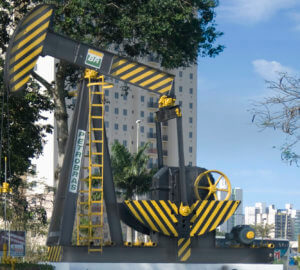 meeting place one of my contacts established, “The entrance to the city”. I assume I am looking for some sort of archway, but I soon discover that the entrance is highlighted by striped oil derrick set up in the middle of a roundabout. A derrick being the icon for the petroleum resource which enriches this city of half a million souls.
meeting place one of my contacts established, “The entrance to the city”. I assume I am looking for some sort of archway, but I soon discover that the entrance is highlighted by striped oil derrick set up in the middle of a roundabout. A derrick being the icon for the petroleum resource which enriches this city of half a million souls.
My new friend is Paulo Cezar Fontoura, of the music education organization Orquestrando a Vida (OAV). When I pull over to call him and set up a revised meeting place, he quickly arrives to me and we both greet by the road, a friendly half embrace with hand shake. I had met him and three of his associates when I attended a presentation they made to the Public Affairs section at the Rio de Janeiro Consulate General the previous month. Paulo drives ahead and leads me to my hotel. He asks me if I want to rest in my room prior to the musical event we will attend. I reply that I only have a very short time to visit the area. “I’m ready to see Campos!” I exclaim, and he agrees to return in an hour.
The city’s full name is Campos dos Goytacazes, after the indigenous peoples who encountered the Portuguese colonizers and who thereupon put up some ferocious but futile resistance to the incursions. And the “campos” part is easy to understand, as the area is relatively flat, about fifty miles between the foothills and the ocean.
I am told that the name was simply “Campos” until a couple of decades earlier, when a historically-minded city government wished to honor the native heritage of the Goytacazo Indians and found city funding to erect a two story tall, fiberglass sculpture of a warrior at the town entrance. In 2006, the statue was taken down and not replaced, and the photos I find on line make me sad for its untimely demise. It lies in pieces near a storage building. But the full name of the town is still a source of pride for the people here. For me, the “dos Goytacazes” part is a challenge for me to remember–and pronounce, without jumbling the syllables.
Campos is growing! The discovery of nearby petroleum deposits in the mid ‘70s began a slow but steady pace of economic activity, which has only quickened since the more recent worldwide attention to the off shore, “pre-sal” resources. The central part of the city in which I was lodging was typical of large cities throughout the state, with bustling businesses, condominium and office buildings of up to 22 stories, well paved streets, historical sites, and some older sections which were being attended to.
At sunset I ride with Paulo and tell him more about the “Rota 66” program I’m participating in. We are en route through the busy Campos roads, past the city’s historical center, which features many classical and colonial structures, such as the municipal hall and cathedral. We are to attend a concert of Orquestrando A Vida’s most elite musicians. The non-governmental music organization is based upon a Venezuelan social improvement model formed in the mid ‘80s, which employs classical and technically challenging music as a core for community and camaraderie. One of El Sistema’s tenants is that the older and more experienced students become teachers and role models for the younger ones, and I later see this in action in the OAV classrooms. At El Sistema’s schools, virtually all of the students are from the disadvantaged neighborhoods–which in Brazil means favelas and comunidades.
We arrive at the modern Teatro Trianon, built in 1998 and the largest theater in the state’s interior. I realize I am a sort of guest of honor when I am escorted to a VIP room with a sign on the door, “Welcome Vice Consul…and Mayor”. Here I meet for a second time since their visit to the Rio Consulate: the NGO’s president, Jony William, Producer Charles William Vianna, and one of the orchestra’s talented and youthful conductors, Marcos Rangel. Soon, we are in the 800-seat auditorium, which quickly fills to capacity. Tonight’s performance features OAV’s most professional musicians, most of whom are younger than 17, which comprise the Mariuccia Iacovino Symphonic Orchestra. Under the practiced baton of Luis Mariceio Carniero, they are spotlighting seven visiting guest musicians and singers from the Transfonica Orchestra in Minas Gerais, a neighboring state.
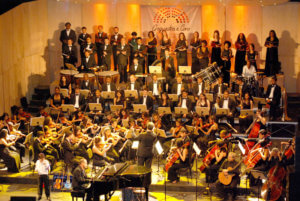 The next two hours are a thrilling and moving musical ride, as the hall resonates with rich sounds. Seated in a place of honor, next to key officials, I am astounded by the caliber of output from the student musicians; it truly sounds as professional as that of any world orchestra. The pieces are arrangements from well known movies and television shows, and full of emotion and energy. For some of the eleven pieces, the youngsters are joined by one of the nation’s premier musicians, pianist and violinist Marcus Viana. As the performance draws to a close, I am really wishing someone recorded it on video, so I might later relive each piece.
The next two hours are a thrilling and moving musical ride, as the hall resonates with rich sounds. Seated in a place of honor, next to key officials, I am astounded by the caliber of output from the student musicians; it truly sounds as professional as that of any world orchestra. The pieces are arrangements from well known movies and television shows, and full of emotion and energy. For some of the eleven pieces, the youngsters are joined by one of the nation’s premier musicians, pianist and violinist Marcus Viana. As the performance draws to a close, I am really wishing someone recorded it on video, so I might later relive each piece.
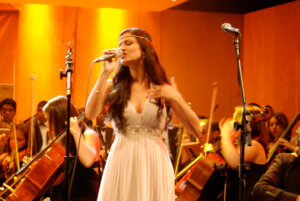 The audience reluctantly disperses after the encores, and I climb up onto the stage and meet some of the OAV musicians. I want to thank them not only for their performance but dedication to music studies. I know a bit about the discipline required to excel musically, as my own daughter is a recent graduate of a school of music and much of the past 15 years of our lives have centered around her music studies. The night ends late for me, as one handshake and photo leads to many more, and in the lobby are the lovely singers and virtuoso instrumentalists everyone wants to feature in their Facebook. I return to my hotel with the tunes of the evening still humming in my head.
The audience reluctantly disperses after the encores, and I climb up onto the stage and meet some of the OAV musicians. I want to thank them not only for their performance but dedication to music studies. I know a bit about the discipline required to excel musically, as my own daughter is a recent graduate of a school of music and much of the past 15 years of our lives have centered around her music studies. The night ends late for me, as one handshake and photo leads to many more, and in the lobby are the lovely singers and virtuoso instrumentalists everyone wants to feature in their Facebook. I return to my hotel with the tunes of the evening still humming in my head.
Since I have just one day for scheduled meetings the following day, I have narrowed the focus of this initial “Route 66” trip to three areas: Education/Culture/Oil and Gas. I am driven to my first stop of the day, an important technical university, by Thomas Kromann, an Oil and Gas consultant working with the Campos government. I initially meet Dr. Marcelo Neves Barreto, a petroleum engineer with the Ministry for Petroleum Development. I am provided a very helpful overview of the oil and gas industry in the area and told that Campos was the first region in Brazil to produce ethanol from sugar cane. Really, Campos seems to have quite a few superlatives, including being the first city in all of South America to be wired for electricity, in the 1830s. And, off the nearby coast, the Campos Basin is the largest petroleum province of Brazil, responsible for some 85% of national production.
I discover that the Campos-Macãe region serves as an educational hub in sync with needs of the oil and gas industry, especially since the waking of the giant which is pre-sal petroleum deposits. Recent exploration has detected the existence of huge petroleum reserves in the portion of underground layers some kilometers below the sea floor. I won’t have the time to visit it on this visit, but at nearby Açu is a new superport being built by the Chinese, due to open next year. Yet another superlative for Campos, it will be the largest industrial port enterprise in Latin America, moving 350 million tons per year. Promising to generate 50 thousand jobs, the port operation will power the transformation of the region and provide the needed infrastructure to grow the petroleum industry.
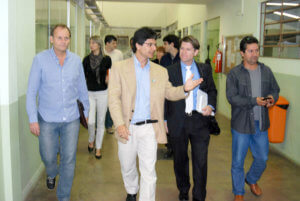 On the walking tour of the main IFF campus, I’m able to see some of the classrooms where the future generation of technological workers is taking shape. I meet teachers and students who are involved in a variety of courses, from electronics to computer programming to hydraulics–very impressive stuff! With seven campuses devoted to technology and pedagogy, the university has also carved out a special mission, to reduce the national deficit of teachers in the areas of chemistry, physics, biology and mathematics.
On the walking tour of the main IFF campus, I’m able to see some of the classrooms where the future generation of technological workers is taking shape. I meet teachers and students who are involved in a variety of courses, from electronics to computer programming to hydraulics–very impressive stuff! With seven campuses devoted to technology and pedagogy, the university has also carved out a special mission, to reduce the national deficit of teachers in the areas of chemistry, physics, biology and mathematics.
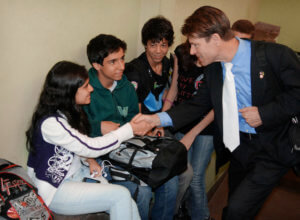 In the afternoon, I visit another important institution, the North Fluminense State University (UENF), focused primarily on academic research and vocational technology. Founded more than 100 years ago, the school holds the distinction of creating the first undergraduate course in petroleum exploration engineering in Brazil. At a meeting with Dean of Students, Silvério de Paiva Freitas; Assistant Dean Carlos Logullo, and Advanced Materials Professor Carlos Fontes Vieira, they mention that 60 percent of the employees of the national petroleum company, Petrobras, are UENF graduates.
In the afternoon, I visit another important institution, the North Fluminense State University (UENF), focused primarily on academic research and vocational technology. Founded more than 100 years ago, the school holds the distinction of creating the first undergraduate course in petroleum exploration engineering in Brazil. At a meeting with Dean of Students, Silvério de Paiva Freitas; Assistant Dean Carlos Logullo, and Advanced Materials Professor Carlos Fontes Vieira, they mention that 60 percent of the employees of the national petroleum company, Petrobras, are UENF graduates. 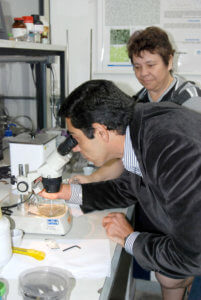 The school also has a thriving, multi-level English program; the language is a requirement for employment in many of the petroleum industry jobs. On a tour of the campus, I meet some of the dedicated department deans like Dr. Ana Diegues Skury, who shows me a laboratory where industrial grade diamonds are manufactured. When Professor Viera focuses the microscope, I’m amazed to see these tiny jewels up close and personal, and later see how they are coated onto the cutting edges of specialized saws.
The school also has a thriving, multi-level English program; the language is a requirement for employment in many of the petroleum industry jobs. On a tour of the campus, I meet some of the dedicated department deans like Dr. Ana Diegues Skury, who shows me a laboratory where industrial grade diamonds are manufactured. When Professor Viera focuses the microscope, I’m amazed to see these tiny jewels up close and personal, and later see how they are coated onto the cutting edges of specialized saws.
Next for me is a visit to a small settlement community, Baleeira, a historically disenfranchised favela which is seeing important improvements in recent years. It’s important for me to see different economic sectors, and speak with the people everywhere in Campos. I’m escorted by Paulo on this day, When I exit the car, three reporters want to interview me about the exciting news that OAV recently inaugurated a feeder school for young musicians, but I demur until I can see and hear more in the community. I am introduced to Maria da Penha, the community coordinator, who welcomes me with a huge smile and warm words.
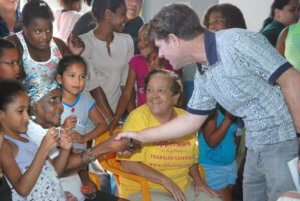 We enter the neighborhood association building and I am surprised to receive a rousing cheer from about 100 people of all ages inside. There is a small orchestra of some 40 students awaiting my arrival and after a few introductions, they immediately start playing some classical selections. I am surrounded by dozens of youngsters, all of whom want to talk to me or hold my hand. After the mini concert, I am asked to pose for photos with some of the audience and performers, then it’s time to answer a variety of questions from two television and three newspaper reporters. I focus on the Rota 66 program and the importance of music and education.
We enter the neighborhood association building and I am surprised to receive a rousing cheer from about 100 people of all ages inside. There is a small orchestra of some 40 students awaiting my arrival and after a few introductions, they immediately start playing some classical selections. I am surrounded by dozens of youngsters, all of whom want to talk to me or hold my hand. After the mini concert, I am asked to pose for photos with some of the audience and performers, then it’s time to answer a variety of questions from two television and three newspaper reporters. I focus on the Rota 66 program and the importance of music and education.
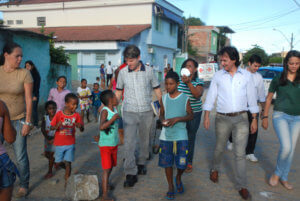 On a tour of the community, I am escorted by Sra. da Pehna and residents Robson Damion and Carita Abreau. I learn about the successes of new projects, that there is a health clinic and some employment programs. We pause on a road by the town cemetery and discuss some of the challenges facing the community’s youth. I am touched by the friendly nature of everyone I meet along the way. I also chat with officers of the military police, to find out the pulse of the anti-crime efforts underway similar to those of Rio de Janeiro. .
On a tour of the community, I am escorted by Sra. da Pehna and residents Robson Damion and Carita Abreau. I learn about the successes of new projects, that there is a health clinic and some employment programs. We pause on a road by the town cemetery and discuss some of the challenges facing the community’s youth. I am touched by the friendly nature of everyone I meet along the way. I also chat with officers of the military police, to find out the pulse of the anti-crime efforts underway similar to those of Rio de Janeiro. .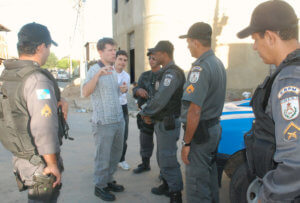
I ask Paulo if we can walk further into the community so I can make photos, and I am pleased to take one photo, a small neighborhood gathering under looming sky, which I believe would be a fine addition to my “Walls/Spaces” fine arts series. 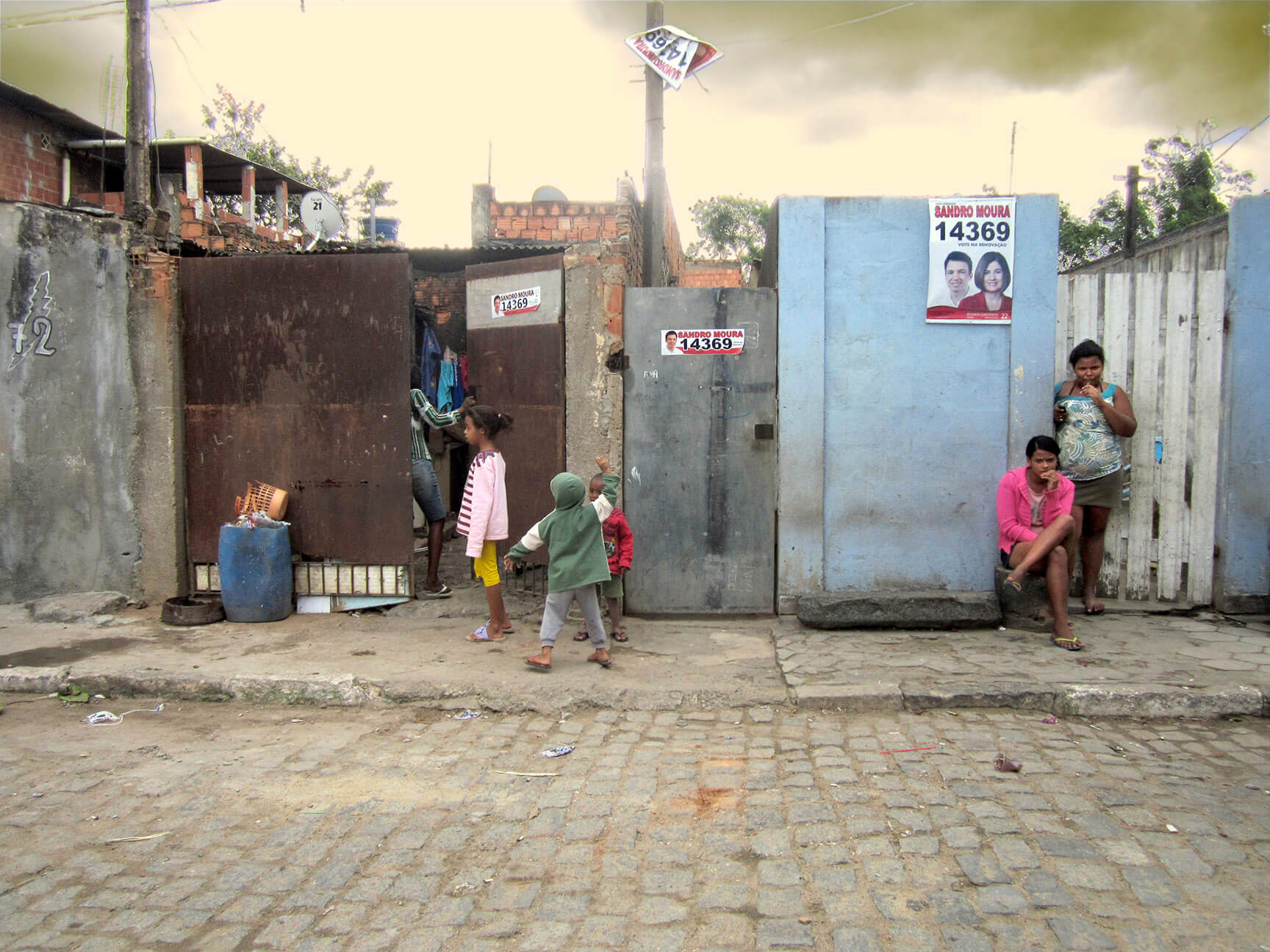 After some minutes, all of a sudden Paulo stops me to warn that we are now in a very dangerous neighborhood. An intimidating young man leaning on a motorbike glares at us, because we have inadvertently walked over an informal border line of small stones in the street, demarcating the drug zone. Trying to disarm the fellow, I speak to him in Portuguese, asking him if I can take his photo.
After some minutes, all of a sudden Paulo stops me to warn that we are now in a very dangerous neighborhood. An intimidating young man leaning on a motorbike glares at us, because we have inadvertently walked over an informal border line of small stones in the street, demarcating the drug zone. Trying to disarm the fellow, I speak to him in Portuguese, asking him if I can take his photo. 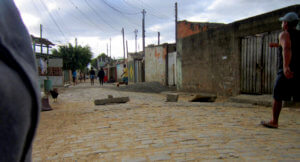 I have long found that some of the world’s toughest people have a desire to be photographed, but in this case the tough sternly declines. Paulo and I carefully retrace our steps away from the scary situation and return to the city center. Another close call in my lengthy history of such escapes –– and one which I will not include in my official report for Consulate!
I have long found that some of the world’s toughest people have a desire to be photographed, but in this case the tough sternly declines. Paulo and I carefully retrace our steps away from the scary situation and return to the city center. Another close call in my lengthy history of such escapes –– and one which I will not include in my official report for Consulate!
Upon our return, it’s time to present Sra. da Penha with maps and books from our Consulate library, and she is moved and grateful. I would love to stay longer, but I have some more appointments this afternoon and must move on, so we hug and I promise to return soon.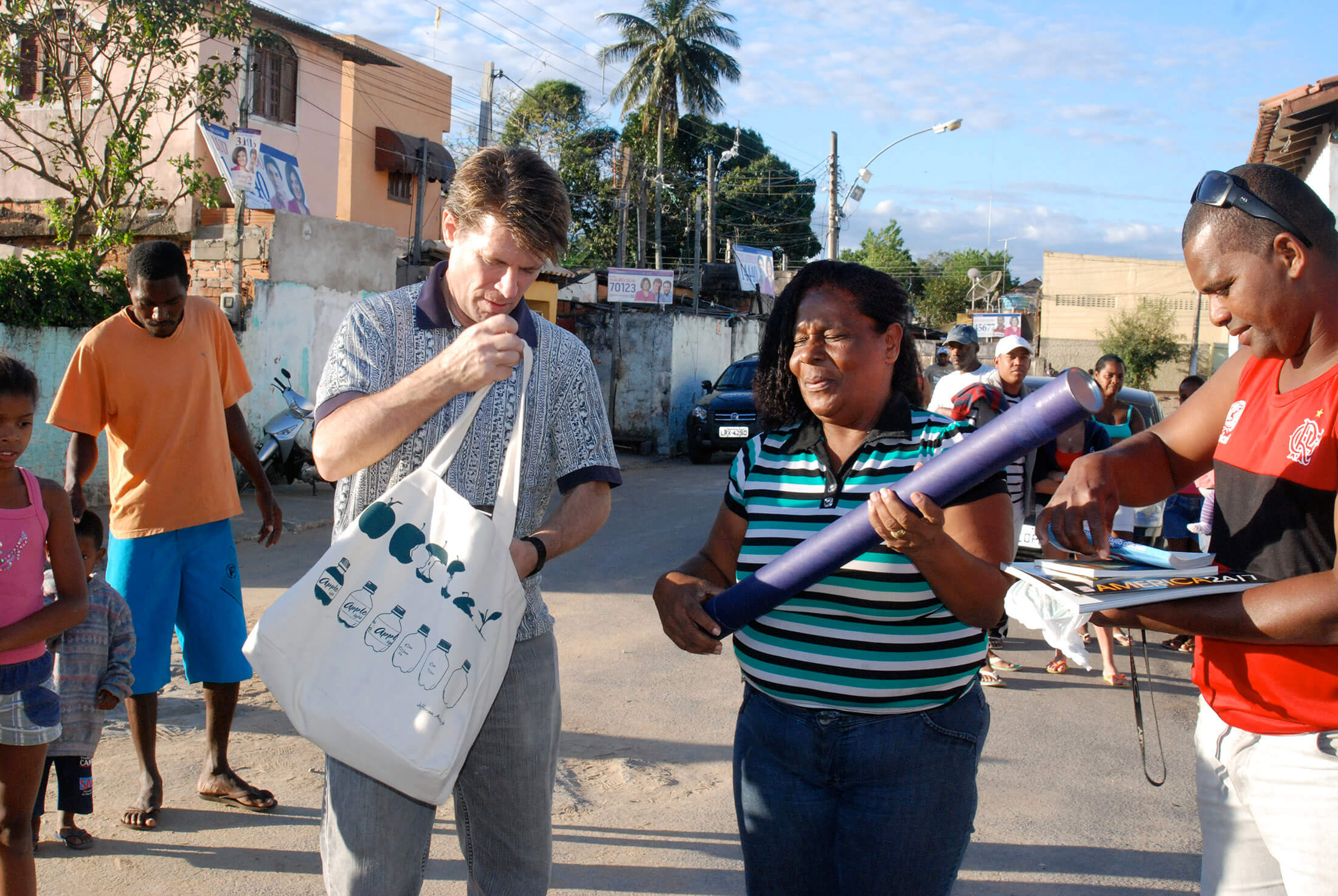
Paulo drives me back to the city center, where I have scheduled a meeting at the Instituto Brasil/Estados Unidos (IBEU), with Director Douglas Jay Moraes. At dinner at a nearby Mexican-style restaurant, Douglas tells me some stories of his happy times living in the USA, and I learn more about Campos and the region. Then he and I drive to another performance of Orquestrando A Vida, this time with student musicians who compose the Orquestra Sinfônica Mariuccia Iacovino. The venue is the main auditorium of Campos Social-Commerce Services (SESC) facility. 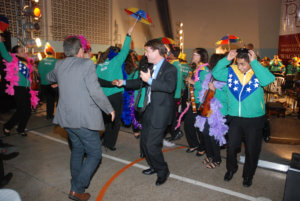 We enjoy ourselves immensely (at one point both responding to the invitation of musicians to dance in the aisles) and, again, I am hugely impressed by the talent and tonal quality of the young musicians. They accompany three famous Brazilian musicians, Wagner Tiso on the cello, his daughter India Tiso singing and Marcio Malard on bass. It’s another free performance, and my OAV hosts respond to my inquiry on funding by telling me of how the city sponsors such performances on a regular basis. What a cultural bonus for all the citizens!
We enjoy ourselves immensely (at one point both responding to the invitation of musicians to dance in the aisles) and, again, I am hugely impressed by the talent and tonal quality of the young musicians. They accompany three famous Brazilian musicians, Wagner Tiso on the cello, his daughter India Tiso singing and Marcio Malard on bass. It’s another free performance, and my OAV hosts respond to my inquiry on funding by telling me of how the city sponsors such performances on a regular basis. What a cultural bonus for all the citizens!
The next day I should be driving back to Rio, but I wanted to learn more about Campos, the OAV school and programs, and spend the morning with the three famous musicians from the night before as we are given a grand tour and introduced to the five different orchestras and the chorus. 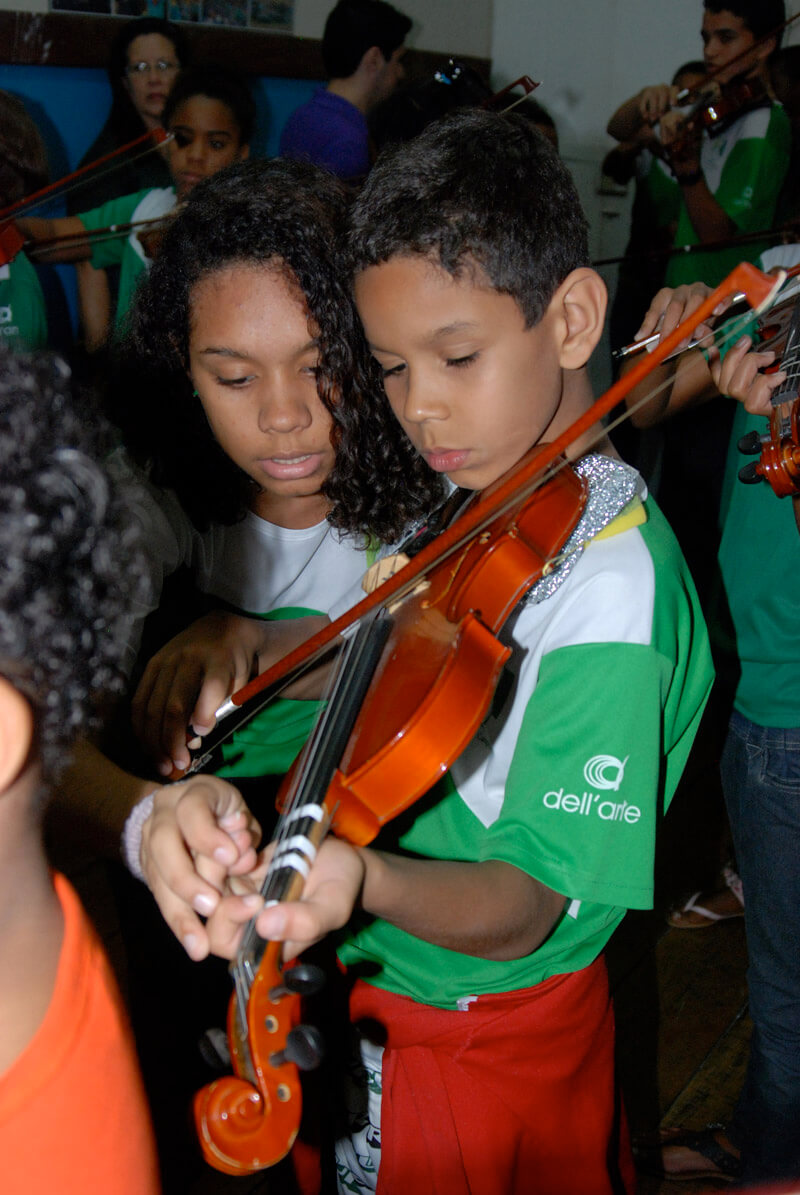 Each orchestra gives us a short performance, and we also see the many rooms in which they practice. There are so many students, they must also practice in the hallways; and there are not enough instruments, so only the highest level orchestra members can take them home. Music turns out to be an excellent lever for structure, discipline and educational success, and everything I see at OAV underscores the benefits of this approach.
Each orchestra gives us a short performance, and we also see the many rooms in which they practice. There are so many students, they must also practice in the hallways; and there are not enough instruments, so only the highest level orchestra members can take them home. Music turns out to be an excellent lever for structure, discipline and educational success, and everything I see at OAV underscores the benefits of this approach.
After the stirring performance of the senior group, I offer to say some words to the students and staff. Speaking in Portuguese, I tell of my own musical experiences, and mention my daughter’s successes in music composition and conducting. 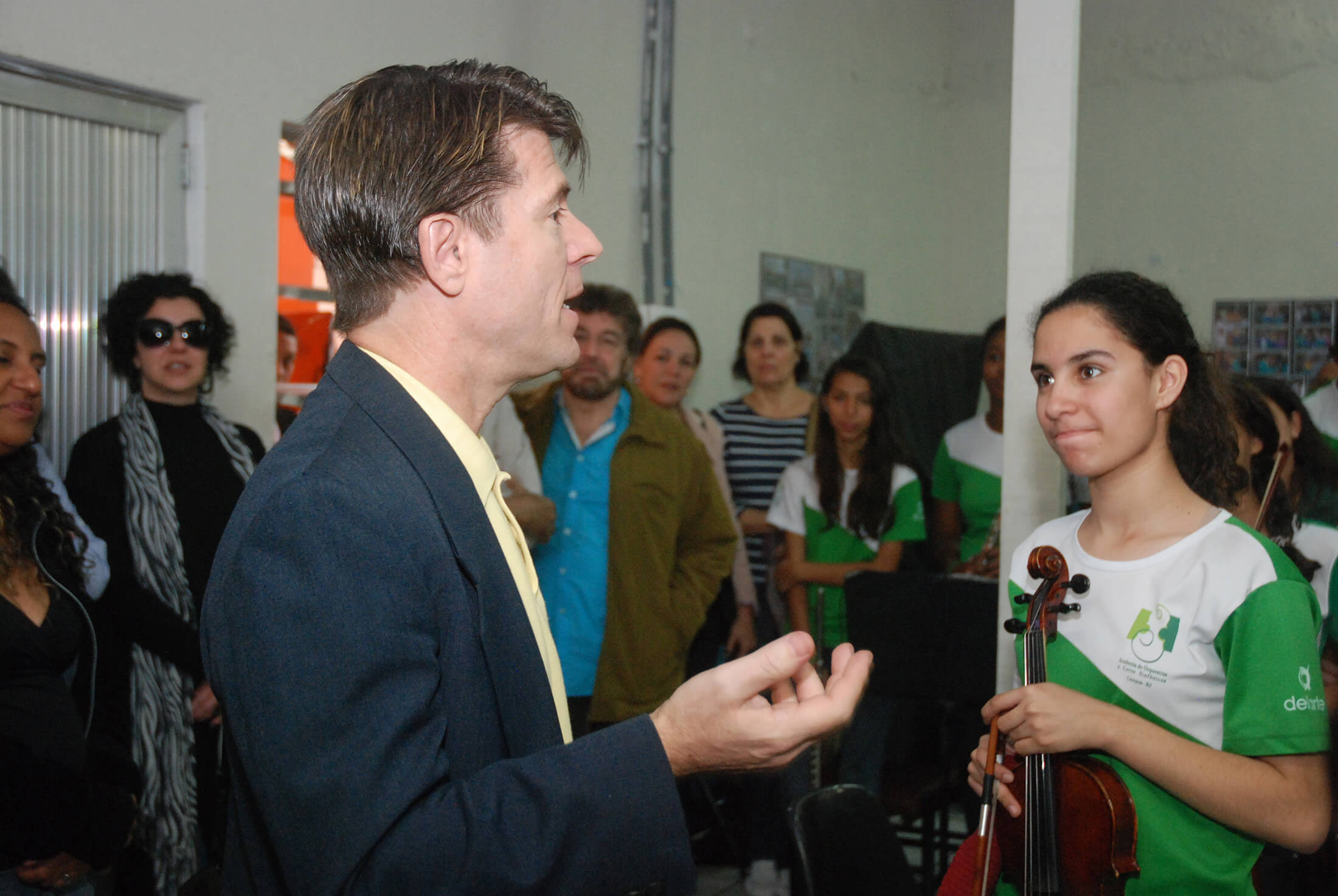 I struggle to contain my emotions at one point, since music has been integral to my life since childhood. My parting comment is from the heart: “It doesn’t matter what are your class or clothes, but dedication, hard work and spirit are what make for success in life”.
I struggle to contain my emotions at one point, since music has been integral to my life since childhood. My parting comment is from the heart: “It doesn’t matter what are your class or clothes, but dedication, hard work and spirit are what make for success in life”.
The group’s director, Jony William later tells me, “Constantly we face financial challenges, but our vision is that we have 5,000 students in this program. Our mission is simply that these youngsters be happy. Music is an instrument, a marvelous tool to this end. It’s not important that the kids be great musicians, but that they be happy.”
Later that day, I also briefly meet with Joilza Rangel Abreau, the municipal secretary of education. We discuss some of the experiences I’ve had at the two universities and promise to get together again on my next visit. I then stop at the offices of one of the newspapers which interviewed me, to follow up with a reporter with more details about the Rota 66 Program. Then, at the Praça San Salvador, I spend an hour chatting with friendly and inquisitive young college students who are preparing a “flash mob” 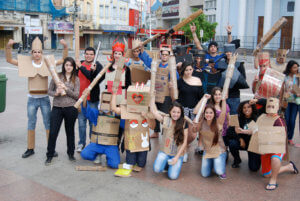 experience, a sort of street battle with toy weapons made of cardboard. Finally, on my way out of town, I attend a special celebratory ceremony by the oil derrick at the city entrance and meet Patricia Cordeiro, president of a cultural NGO, Fundação Cultural Jornalista Oswaldo Lima, which offers popular culture courses at various venues throughout the city.
experience, a sort of street battle with toy weapons made of cardboard. Finally, on my way out of town, I attend a special celebratory ceremony by the oil derrick at the city entrance and meet Patricia Cordeiro, president of a cultural NGO, Fundação Cultural Jornalista Oswaldo Lima, which offers popular culture courses at various venues throughout the city.
The drive home, through the flatlands offering spectacular vistas, offers me a good opportunity to reflect on all I experienced during my brief visit in Campos. The friendliness of her citizens and the opportunities of employment, educational and cultural experiences are fertile ground for the sense of optimism and pride I sensed everywhere. I have no doubt that Campos dos Goytacazes will be a source of superlatives for many years to come. 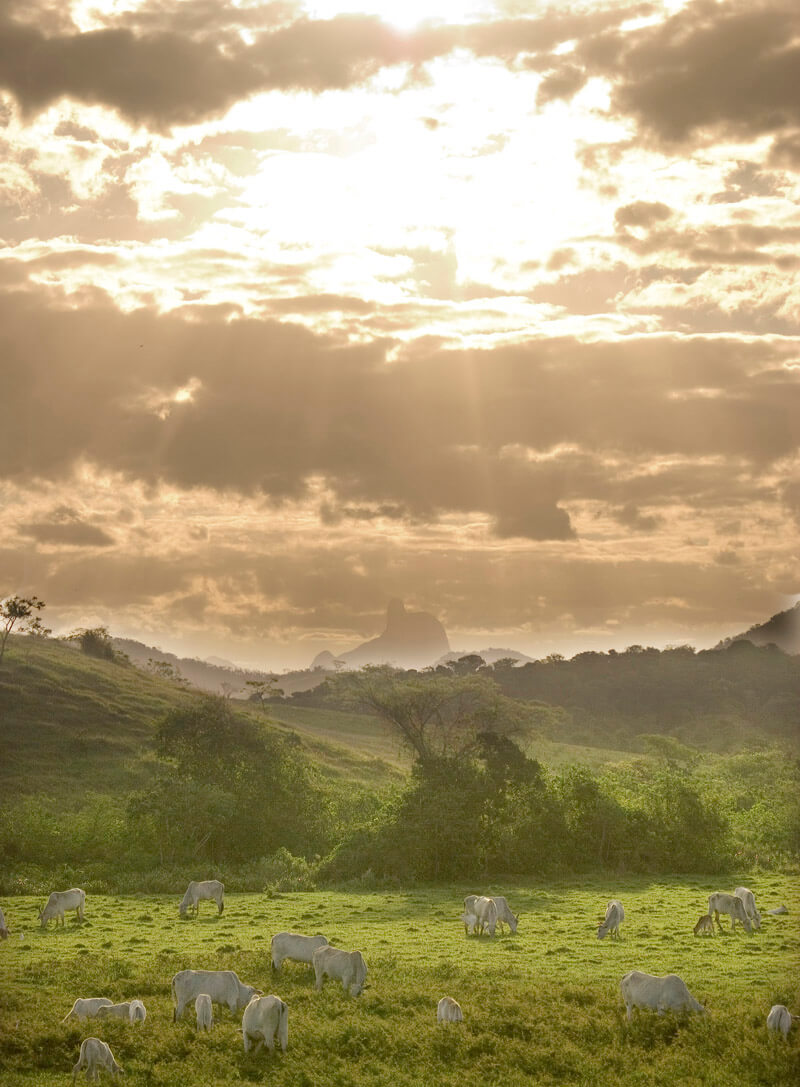
MEDIA LINKS:
Globo.TV: Projeto Inaugura Núcleo de Música em Comunidade de Campos, RJ
28-SEPT-2012 (Television airings plus Web story with video): http://g1.globo.com/rj/serra-lagos-norte/noticia/2012/09/projeto-inaugura-nucleo-de-musica-em-comunidade-de-campos-rj.html.
Journal Ururau: Representante do Consulado Americano Visita Comunidade da Baleeira
28-SEPT-2012 (Web Story, with 6 photos) http://www.ururau.com.br/cidades21959
Journal Terceira Via: Visita do Vice-Cônsul dos EUA a Campos Leva Esperança a Moradores da Comunidade Baleeira. Ele conheceu a ONG de perto e caminhou pela comunidade para conhecer a região
29-SEPT-2012 (Newspaper article; Web story, 5 photos) http://www.jornalterceiravia.com.br/noticias/campos_e_regiao/5921/visita_do_vice-consul_dos_eua_a_campos_leva_esperanca_a_moradores_da_baleeira
IFF (University Web Site of Instituto Federal de Educação Ciéncia e Tecnologia): Mostre-se Realiza Atividades da Etapa Final
28-SEPT-2012 (Web Story) http://portal.iff.edu.br/campus/campos-centro/noticias/mostre-se-realiza-atividades-da-etapa-final/?searchterm=%22john%20elliott%22
Informativo da UENF: Vice-cônsul dos Estados Unidos Visita a UENF
01-OCT-2012 (Web Story) http://uenf.br/dic/ascom/informativo-da-uenf-01-10-12/
Journal Terceira Via: Vice-cônsul dos Estados Unidos Visita Comunidade da Baleeira. Com uma agenda variada, John Elliott participa de programações culturais em Campos. 29-SEPT-2012 (Web Story) http://www.jornalterceiravia.com.br/noticias/campos_e_regiao/5915/vice-consul_dos_estados_unidos_visita_comunidade_da_baleeira
Globo.TV (RJ INTER TV 2ª EDIÇÃO): Projeto Inaugura Núcleo de Música em Comunidade de Campos, RJ
29-SEPT-2012 (Streaming video only): http://g1.globo.com/rj/serra-lagos-norte/noticia/2012/09/projeto-inaugura-nucleo-de-musica-em-comunidade-de-campos-rj.html
Folha Online: Chegou Lá
29-SEPT-2012 (Web Story with photo) http://www.fmanha.com.br/cultura-lazer/chegou-la
O Diario: A Menina Agora Ensina
27-OCT-2012 (Web Story with photo) http://www.odiariorj.com/a-menina-agora-ensina/
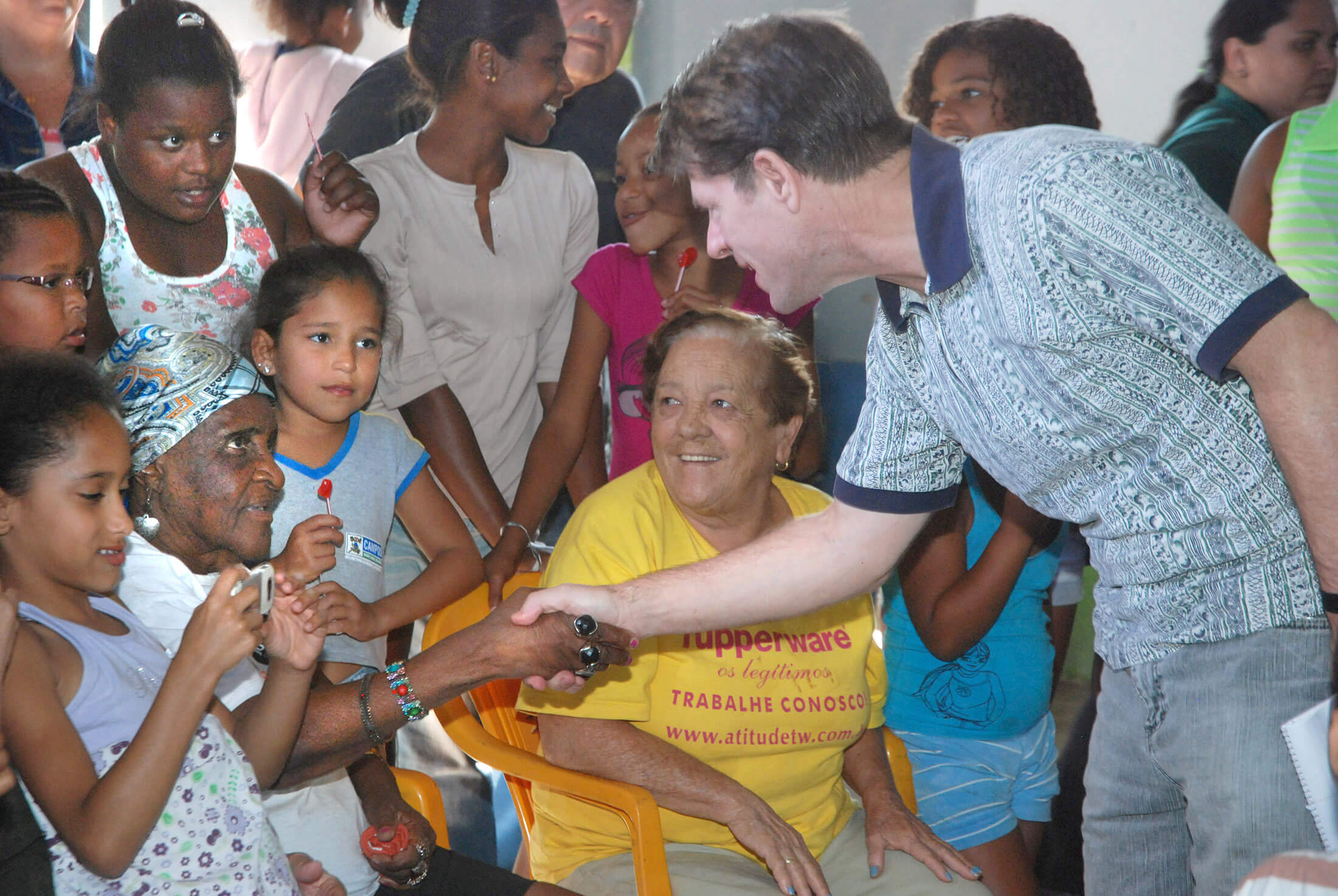

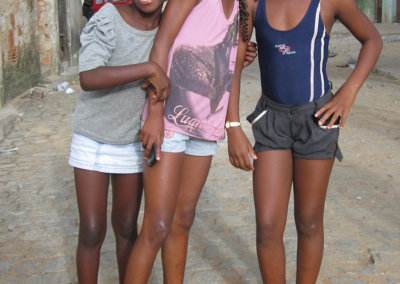
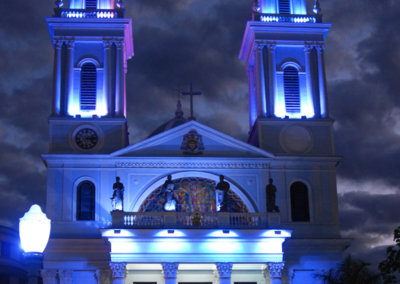
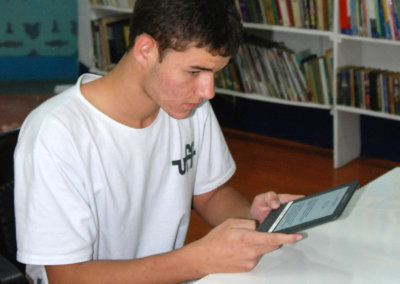
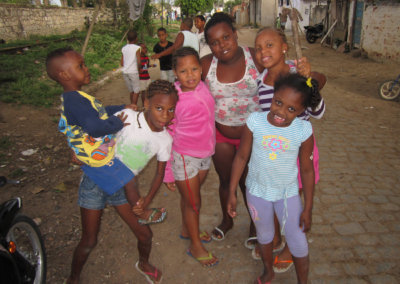
0 Comments